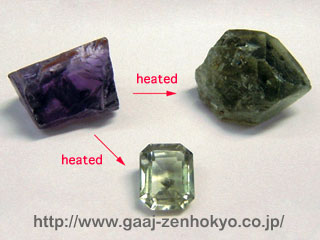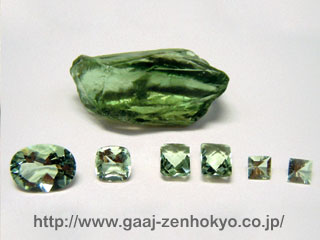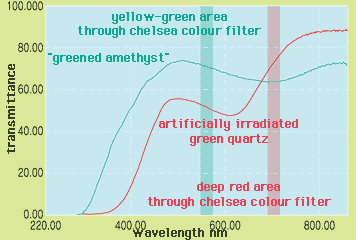|
||||||||||||||||||||||||||||||
|
Some amethysts from certain localities alter the colour to green when heated under appropriate condition. They are known as gprasioliteh or ggreened amethysth. A large amount of green quartz in the similar colour has been on the gem market since early last year and they are for sale in inexpensive price. These stones were studied and then proved that they were not greened amethyst but actually irradiation-treated quartz. Synthetic green quartz, although in small quantity, is also available on the market. Identification of green quartz is becoming more complicated today because of these factors.
Natural Quartz in Green Colour It is now commonly known that amethyst changes colour when it is heated. Most of amethyst changes to yellow and brownish yellow after being heated to between 350ºC and 550ºC, which is the way to obtain citrine from amethyst. Then the citrine changes to colourless or milky after further heating at over 600ºC. However, the outcome cannot always be predictable because individuality, sectors in crystal or difference in locality may largely influence the results. The amethyst from Montezuma in Minas Gerais state, Brazil, has been called gprasioliteh or ggreen amethysth (photo 1), which was reported in 1950s that it changed to green by heating at about 400 to 500. Materials from Four Peaks in Arizona (USA), around the border between California and Nevada states (USA) and Zimbabwe are also known to change to green similarly. The area around the border of the states is particularly interesting as it produces unusual naturally coloured green quartz.
In this area, basalt and andesite rocks that had been erupted in Jurassic period about 140million years ago are scattered. Accompanied by these igneous rocks, rock crystal, naturally coloured amethyst, citrine and green quartz have been extracted. According to literatures (Paradise, 1982), colourless quartz containing trace of iron had gradually developed colour centre in geological time scale by accepting gentle natural irradiation from the earth to finally emerge the amethyst colour. The material was subsequently heated in natural process when rhyolitic magma intruded in Oligocene epoch, the third Cenozoic period, and it turned to citrine or more scarcely to green quartz. Currently, however, colour cause of this natural green stone cannot be distinguished from that of artificially heated green stones such as from Montezuma. Let alone naturally coloured green quartz, ggreened amethysth produced by heating amethyst is far fewer in quantity than amethyst or citrine. Nevertheless green colour quartz suddenly appeared on the gem market last year. A large amount of inexpensive green colour quartz was for sale as gprasioliteh. Those stones were later inspected and proved to have been artificially irradiated (+ heated?) so that the name gprasioliteh or ggreened amethysth is not appropriated for this material. This type of green quartz obtained by irradiation treatment appears reddish through the Chelsea colour filter. This response can clearly differentiate the material from the heated amethyst, so-called ggreened amethysth, which appears green (i.e. inert) through the colour filter. The Chelsea colour filter was originally designed to identify emerald and it is also called emerald filter. Many emeralds such as from Colombia appear red to faint red through the filter, while many emerald simulants such as green glass appear green. This is derived from the principle of the filter which transmits only deep red and yellow-green area and absorbs all other colour region of a spectrum. As shown in the figure 1, so-called ggreened amethysth has higher transmission rate in yellow-green region than in deep red region thus makes the stone appear green through the colour filter. Contrary to this, artificially irradiated green quartz has higher transmission rate in deep red area than in yellow-green area so that the stone appears red through the colour filter.
Description of the stone on an identification report is as follows; Traditional type (green quartz produced by heating amethyst)
Green Quartz obtained from irradiation
|
||||||||||||||||||||||||||||||
|



